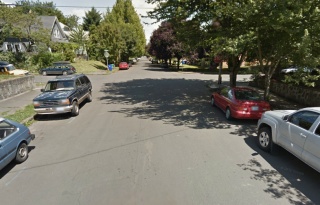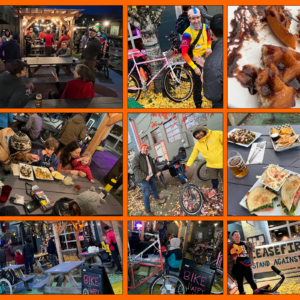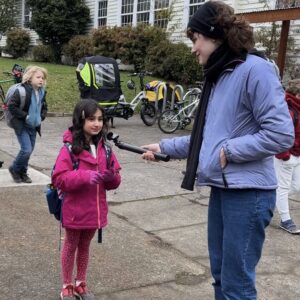
Whenever we report on a new neighborhood greenway project, the discussion always turns to diversion. That is, how will the project promote or prevent a higher volume of driving on a street specifically set aside by the Bureau of Transportation to have “low traffic volume and speed where bicycles, pedestrians and neighbors are given priority.”
Last week we shared PBOT’s first swing at plans to turn NE Rodney into just that sort of street. And sure enough, many readers asked about diversion.
Reza wrote;
“Can we get some diversion please? Rodney near Russell gets a lot of car traffic from motorists going to Wonder or other nearby establishments continually circling the block for on-street parking.”
Craig Harlow wrote;
“PBOT, please start installing diverters along ALL of the n’hood greenways.”
and Amy Subach wrote;
“Diverters are essential–not speed bumps–if you want to keep cars from blasting down the stop-sign reduced route. I think speed bumps are annoying and ineffective compared to diverters. And since there is never any speed enforcement on the greenways, we need to discourage cars from using them as alternates to major arterials.”
Given what an obvious issue diversion is whenever these projects come up, I had my own hunches as to why PBOT doesn’t talk about them at the outset of a project. First, they’re controversial: Diverters not only force residents to change their behaviors, but they can also have the impact of moving traffic to another street, which almost always riles people up. Second, they’re expensive: Compared to the cost of sharrows, signage, and a few speed bumps, median islands can jack up the price of an otherwise “affordable” project. And third, because of the first two reasons, any talk of diversion can turn a quiet little project into a potential controversy — something PBOT avoids like the plague.
More common for PBOT is to get a project on the ground, then wait and see how traffic patterns evolve. Then, if diversion is needed, they have the data and neighborhood support (a.k.a. political cover) to make it happen. This is how the scenario played out on my street, N. Michigan Ave. Because some neighbors protested a full median diverter at N Rosa Parks Way, PBOT backed away from it. But they promised to come back later and put it in if it was necessary after the other changes were made. It was. So they did. And now all is well and good.
But those are just my hunches, so I decided to ask PBOT directly to find out what they’re thinking. Here’s what Rodney project manager Rich Newlands shared with me (via email), when asked about diversion on Rodney:
Our conventional wisdom is:
- Neighborhood Greenways work simply when speeds are near 20 mph and volumes below 1,000 cars/day. Diversion in other words is not an assumed pre-requsite to achieve those conditions.
- We try to be very careful when using it because sometimes it only diverts traffic from one local street to another (our policy is that diversion is allowable only if it diverts non-local traffic to a higher classification street). It can be tricky to get it to work as intended.
On Rodney:
- Diversion has always been a consideration and still is ‘on the table’.
- There is no traffic volume evidence that there is a significant cut-through traffic issue currently. Planned changes to N Williams may change that, but maybe/hopefully not. Our assumption going in in terms of travel pattern changes was focused on the impact of the new traffic signal at Cook- a semi-diverter is proposed on the east leg of Cook/Williams intersection to address this.
- I did hear a number of comments at the open house that it’s a concern (hope to have the results complied by the end of the week). However the concern was expressed more in reference to the need to retain some N/S stop signs as the answer.
- What was shown at the open house was just a starting point for this dicussion. We have an internal meeting set up this week to discuss next steps and will be meeting with Eliot NA soon to discuss more. I suspect diversion will be one of the main issues we need to discuss further. We may also want to slow down and wait for the Williams changes to happen first in order to have a better handle on how that project relates to Rodney.
So now you know. Despite the absence of diverters in the plans they showed at the open house, PBOT might still install some diversion measures as part of this project. When/if it gets installed, and whether it comes from stop signs (which would be inconvenient for cycling) and/or from medians (which would be inconvenient for driving), remains to be seen.
Stay tuned.





Thanks for reading.
BikePortland has served this community with independent community journalism since 2005. We rely on subscriptions from readers like you to survive. Your financial support is vital in keeping this valuable resource alive and well.
Please subscribe today to strengthen and expand our work.
What if all existing stop signs were kept, except they had an “except bicycles” sign added to them? That way cars would be less tempted to use the street and bikes wouldn’t have to stop.
“Right turn not required to stop” signs used to be allowed (and still exist in a few places), but new ones aren’t permitted to be installed anymore. I highly doubt state law would allow for an except-bicycles on stop signs.
Furthermore, in order for this idea to work, you’d necessarily need to stop cross traffic for it to be safe for people on the greenway to proceed without a stop. Drivers would figure this out and just run the stop signs.
People driving often look when approaching an intersection to see if there are stop signs for cross traffic. If they see the back of a stop sign, they’ll assume cross traffic will stop, and might proceed through the intersection when a bike is approaching. This could lead to a situation where a person on a bike could get hit, because they technically had the right-of-way but a driver proceeded in a manner that would be legal at any normal 4-way stop intersection.
For all sorts of reasons, this would be confusing to both cyclists and motorists. Diverters really are the solution, to keep drivers from using the boulevard as a shortcut. Also, it would be great to see speed tables with raised crosswalks installed at some intersections, providing dual purpose calming for traffic. One thing that is often lost on bike boulevards is the concept that bikes still have to stop for pedestrians at intersections!
What we need is an Idaho Stop Law. Any chance to that getting through the legislature next session? Anyone hear any talk/rumors/rumblings?
They tried and it failed a few years back. Not to say it can not be brought back up again next session….
“And since there is never any speed enforcement on the greenways . . .”
Yup.
Actually, oddly there has been a Police officer sitting on the Davis Greenway watching the four way stop at 67th at the bottom of the hill from Gilham. That stop sign is run all the time, both by cyclists heading east and drivers heading north down the hill. I have seen him twice the past week…
Davis is not a greenway yet.
Let’s not forget the hundreds of cars that use Rodney most evenings to try and access the Wonder Ballroom. Or the cars using Rodney from the newly opened New Seasons to avoid waiting on Williams to make the print at Fremont.
Diversion is necessary. PBOT can’t keep on with the lame-ass excuses like “Oh, we tried that back in the 70s, and nobody liked it” (Roger Geller’s words almost verbatim at a BikePortland-hosted transportation beer and questions social event filmed and streamed by BikePortland a few years back at Plan B bar in SE.
Four way stops would be better than flipping the signs.
Stop signs are turned to enable a neighborhood greenway to be time-competitive with the busier parallel main street that has bike lanes. Speed bumps are installed to slow auto traffic to 20 mph. Diverters slow down no one, but do reduce auto traffic and any opposing friction along a segment, enabling remaining motorists to go faster.